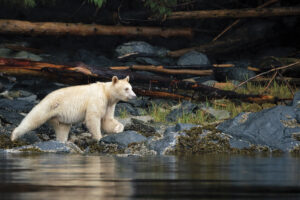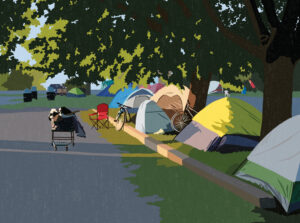
People & Culture
Kahkiihtwaam ee-pee-kiiweehtataahk: Bringing it back home again
The story of how a critically endangered Indigenous language can be saved
- 6310 words
- 26 minutes
This article is over 5 years old and may contain outdated information.
People & Culture

Historical fiction about a renowned poet, a graphic novel that brings together seven famous Canadians on the battlefields of France, the biography of a legendary polar exploration ship and a cultural history of ice are among the books that stood out to the editors of Canadian Geographic and members of The Royal Canadian Geographical Society in 2018. Whether you’re looking for a great holiday read or just trying to check off that last item on your Christmas shopping list, these books won’t disappoint.
Ice
By Klaus Dodds
Reaktion Books
In its 200-odd pages on the natural and cultural history of ice, this smart, fun and fascinating book covers everything from the Northwest Passage and hockey to Margaret Atwood and Top Gun. Dodds, a professor of geopolitics at Royal Holloway University of London and a Fellow of The Royal Canadian Geographical Society, has also packed his book with 95 images — American submarines, Soviet stamps, archival photos of Robert Falcon Scott and NASA images of glaciers among them — that help add to our understanding of how ice has shaped our lives, lands and communities.
—Harry Wilson, deputy editor
In Those Days: Tales of Arctic Whaling
By Kenn Harper
Inhabit Media
In this third volume of his In Those Days series, historian Kenn Harper gives a rare glimpse into the treacherous lives of 19th-century Arctic whalers, who followed the bowhead whale migration into the Canadian Arctic. Through harrowing first-hand accounts from journals and rare historical photographs, the book tells the stories of Arctic whalers, their pursuit of whale bone and oil, and the lasting impression they left on the Inuit with whom they interacted.
—Michela Rosano, associate editor
Erebus: One Ship, Two Epic Voyages, and the Greatest Naval Mystery of All Time
By Michael Palin
Penguin Random House Canada
In Erebus: One Ship, Two Epic Voyages, and the Greatest Naval Mystery of All Time, Michael Palin has written a rolicking biography of the legendary ship, told through the lives (and deaths) of the people who manned her on explorations of Antarctica and the Arctic. With this irresistible, sometimes funny and often harrowing account, he makes a convincing case that this one heroic little ship embodies the golden age of polar exploration better than any other.
—John Geiger, CEO of The Royal Canadian Geographical Society
Lines on a Map: Unparalleled Adventures in Exploration
By Frank Wolf
Rocky Mountain Books
Frank Wolf is one of the world’s most prolific adventurers, a filmmaker, writer, environmentalist and, you might think by about chapter three of Lines on a Map: Unparalleled Adventures in Exploration, perhaps also a serious glutton for punishment. Wolf’s new book collects the best stories from a full 24 of his mainly Canadian expeditions over the past two decades, and the result is a pretty gripping montage of his quests, body-breaking travails and the humour that gets him through. John Vaillant, author of The Golden Spruce, says it best in the forward: “As you make your way … into Wolf’s wild hinterland, you may feel justifiably glad it’s not you in the boat, but I guarantee there will also be moments when you wish to hell you could have been there.”
—Nick Walker, managing editor
Lands of Lost Borders: Out of Bounds on the Silk Road
By Kate Harris
Penguin Random House Canada
Kate Harris lays out her marker as one of the best non-fiction writers in Canada — if not its best travel writer — with her pitch-perfect memoir about cycling the ancient Silk Road trade route with Melissa Yule, her childhood friend. Harris’ prose is at turns spellbinding, wry and contemplative, and her unerring eye — and ear — for detail help make her debut not just a hugely enjoyable read but also one that will stay with you long after you put it down.
—H.W.
The White Darkness
By David Grann
Penguin Random House
In February, The New Yorker published a story about the modern British polar explorer Henry Worsley titled The White Darkness. It was so riveting I immediately re-read it and sent it to several friends and colleagues with the admonition that they MUST read it. The story, which has since been released as a beautifully illustrated hardback book, recounts how Worsley, driven by his admiration for the famed polar explorer Sir Ernest Shackleton, undertook three expeditions to Antarctica. In the first, Worsley and two companions re-created Shackleton’s 1908 journey, reaching Shackleton’s farthest point (97 nautical miles from the South Pole) and surpassing it to reach the pole. In the last, Worsley attempted to re-create — solo — Shackleton’s 1915 trans-Antarctica crossing, with tragic consequences. More than anything, The White Darkness is a haunting exploration of the obsession that drives explorers to submit themselves to almost unbearable suffering in harsh yet beautiful wildernesses.
—Gavin Fitch, President of The Royal Canadian Geographical Society
Group of 7
By Chris Sanagan and Jason Lapidus
groupof7comic.ca
What do John McCrae, A.Y. Jackson, Francis Pegahmagabow, Lester B. Pearson, Frederick Banting, Norman Bethune and Conn Smythe have in common? Well, not much — other than the fact that all seven Canadians were present in Europe during the First World War, lending inspiration to Chris Sanagan and Jason Lapidus’s graphic novel, Group of 7. The first issue was published in 2017, but the series, which weaves together the fictional “untold story” of these men and their friendships, triumphs and downfalls while on a secret mission during the Battle of Vimy Ridge, really hit its stride with the two issues published in 2018. The fourth of a planned six issues is currently being written, and I can’t wait to read it.
—Kiley Bell, copy editor/fact checker
The Man Who Shot Siegfried Sassoon
By John Hollands
Quill Publications
It doesn’t have a Canadian angle, per se, but any Canadian interested in the First World War and the world of literature should enjoy this historical novel about the circumstances surrounding the (non-fatal) shooting in 1918 of Siegfried Sassoon, the British poet best known for his verse about that conflict. The tale involves Sassoon’s about-face from decorated soldier to pacifist and two Welsh brothers — one who copied Sassoon’s anti-war poems and was executed for it, and one who blamed Sassoon for his brother’s death — and draws on information the author gleaned from veterans who actually served with Sassoon. It’s utterly compelling and will surely, in time, be regarded as one of the best war stories ever written.
—Sir Christopher Ondaatje, author, explorer and Vice-Patron of The Royal Canadian Geographical Society
A Feast of Science: Intriguing Morsels from the Science of Everyday Life
By Dr. Joe Schwarcz
ECW Press
Between skeptics of all stripes taking up Donald Trump’s rallying cry of “fake news” and anti-vaxxers harping about the dangers of immunization even as long-dormant diseases rear their heads, these are dark days for the truth. In these credulous times, a book like Dr. Joe Schwarcz’s A Feast of Science is both useful and necessary. In a series of entertaining, easily-digested essays, Schwarcz — who could be considered the anti-Dr. Oz — sets the record straight on everything from genetically-modified crops to alternative cancer cures to those “natural male enhancement” emails clogging your spam folder. Have this book ready to hand next time that Facebook friend you haven’t seen since high school tries to sell you on the health benefits of essential oils.
—Alexandra Pope, digital editor
The Spinning Magnet: The Electromagnetic Force that Created the Modern World and Could Destroy It
By Alanna Mitchell
Viking Canada
Mitchell, one of the preeminent science storytellers in the nation, has taken on a subject most of us probably don’t spend an awful lot of time thinking about — the Earth’s electromagnetic field — and not only makes it accessible but also compels readers to really care about how it’s going to affect them. To say anything more would be to give the game away, but the book’s subtitle gives you a pretty good idea of how important this invisible force is.
—H.W.
Voice in the Wild
By Laurie Sarkadi
Caitlin Press
“Compelling recollections of life on the land in this exclusive @CanGeo excerpt from @LaurieSarkadi’s memoir Voice in the Wild.”
—Aaron Kylie, editor-in-chief
Kings of the Yukon: A River Journey in Search of the Chinook
By Adam Weymouth
Penguin Random House Canada
“Weymouth handles whatever sense of disconnect he may have experienced with verve and aplomb, transforming it into what all great nature and travel writing should provide: a sense of connection to the people and landscapes encountered.”
—H.W.
Lady Franklin of Russell Square
By Erika Behrisch Elce
Stonehouse Publishing
“Imaginatively fills in the gaps through a collection of ‘discovered’ letters from Lady Franklin to her husband [polar explorer John Franklin], penned between 1847 and 1857.”
—N.W.
Defying Limits: Lessons from the Edge of the Universe
By Dave Williams
Simon & Schuster
“A remarkable portrait of one of the most down-to-Earth people to ever go into orbit, and it will resonate with astronauts and the other 99.999999 per cent of the population alike.”
—N.W.
Yes, we’re picking a book — or books, in this case — that we published, but hear me out on this one before your roll your eyes. The Indigenous Peoples Atlas of Canada is not just a phenomenal groundbreaking resource; it’s a phenomenal groundbreaking resource that was conceived and shaped by representatives of the Indigenous organizations listed above, and was exclusively written and designed by dozens of Indigenous contributors from a wide range of cultural backgrounds. And while we’re thrilled to have it lauded by the likes of Margaret Atwood, we’re also honoured to have been able to work with and listen to the Indigenous people of Canada as they told their own stories — stories that every Canadian should hear. As Canadian Geographic contributing editor Julian Brave NoiseCat said in his foreword to one of the atlas’ four volumes, “This atlas brings together voices from First Nations, Métis and Inuit communities, representing the diversity of intellect and profundity of tragedy, comedy and triumph in Indigenous communities from Tkaronto to Tuktoyaktuk and Victoria to Val-d’Or.”
—H.W.
Are you passionate about Canadian geography?
You can support Canadian Geographic in 3 ways:

People & Culture
The story of how a critically endangered Indigenous language can be saved

Places
In Banff National Park, Alberta, as in protected areas across the country, managers find it difficult to balance the desire of people to experience wilderness with an imperative to conserve it

Wildlife
How ‘maas ol, the spirit bear, connects us to the last glacial maximum of the Pacific Northwest

People & Culture
For unhoused residents and those who help them, the pandemic was another wave in a rising tide of challenges